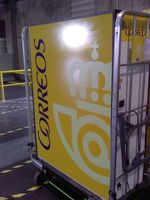One of the world’s largest RFID deployment has gotten larger: Correos, Spain’s postal service provider, has expanded its use of RFID technology, from an initial 16 sorting centers to 56 sites all over Spain. The system uses a total of 65,000 tags to date and could grow to 100,000 tags, according to Joan Pons, the managing director of AIDA Centre, the postal service’s RFID systems integrator. The expansion was announced today at the Post Expo, a postal agency industry conference held in London.
Correos uses RFID to monitor the flow of mail through its sorting centers and to also track the location of reusable bins in which mail is transported. Postal workers place EPC Gen 2 passive RFID tags in envelopes that are addressed to various sorting centers and drop these envelopes into mail collection boxes at various locations. RFID interrogators collect the ID encoded to the tags, along with a time stamp for each read. Back-end software builds a database of these read events, along with the location of the interrogators that capture each ID, and the agency then uses this data to identify bottlenecks and delays in the movement of letters, and rectify them.

After an initial deployment in 2007 (see Spain’s Post Office Improves Delivery Speed), this system proved effective in helping the agency improve mail delivery service. It has installed RFID hardware at 37 additional sorting centers, where Reva Systems‘ Tag Acquisition Processor (TAP) devices are used to network and manage the reader infrastructure at each of the 37 centers. The agency has also greatly increased the number of RFID tags it places into its mail sorting system, from 5,000 in 2007 to more than 50,000 today, says Pons.
At each read point, the unique ID number encoded to each label—along with a timestamp of when the read was taken and a number identifying the location of the reader—is sent to RFID middleware, which records the read event and filters out duplicate reads. In the first wave of RFID deployments, the post office used the Sybase iAnywhere RFID software for this task at 16 sorting centers, and it remains in use at those facilities. At the 37 newly outfitted sorting centers, however, Reva middleware running on the Tag Acquisition Processors handles the tag data. When the letters reach their destinations, the tags are removed, inserted into new addressed envelopes, and dropped again into mail collection boxes.
Pons says that the postal agency has also attached EPC Gen 2 RFID tags to 15,000 reusable bins in the system, as well. The tags are used to track the containers’ locations. He says the agency plans to continue tagging additional bins until all 50,000 used throughout the system are tagged. In total, Correos has installed 550 RFID readers and more than 3,200 reader antennas to read the RFID-tagged envelopes and bins as they circulate through the sorting centers. In addition to being installed around entry and exit points at the facilities, readers are affixed to conveyor systems and sorting machines.
Pons says that AIDA Centre has also created four mobile RFID interrogators that can be used to read the envelope and bin tags on a temporary basis at various small sorting centers where permanent reading infrastructures have not been installed.
“I believe this is one the largest RFID passive technology deployments in the world,” says Pons. “It is used for internal quality control and process improvement, and it is a big milestone for the postal sector.”

